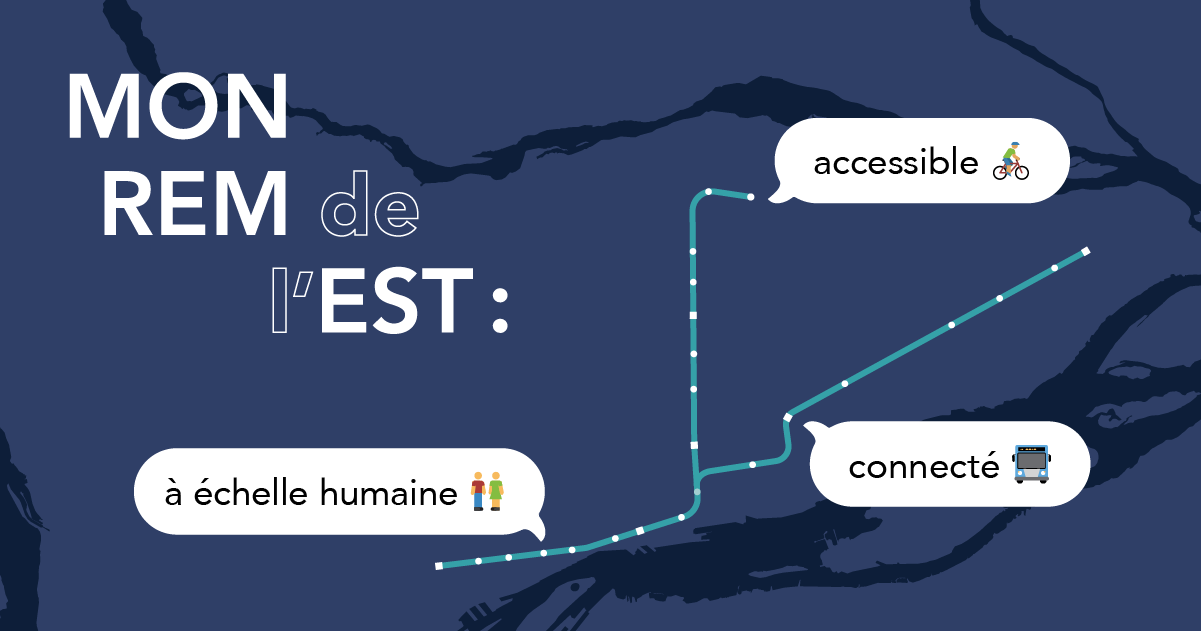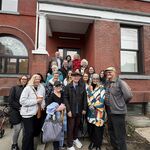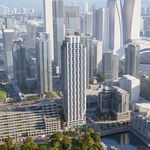CharmAlarm
Active Member
The consultation sessions for REM East have been posted on the REM website with a bit more detail/documentation/maps:



The consultation sessions for REM East have been posted on the REM website with a bit more detail/documentation/maps:

This seems a ... backward way of planning new rapid transit - turning up with a suspiciously fixed proposal with route, station locations, where to build elevated/underground etc.
ironically the entire Montreal-North section will be underground. No luck for the downtown part.
Leslieville is not in Downtown though. And is the OL really elevated through Leslieville? It's on a railway embankment but I don't consider it as a true elevated track.Has a real Toronto vibe to it. Elevated Ontario Line through the downtown east, buried LRT and subways in the suburbs.
Automation is what gets a good return on investment and why the CDPQi doesn't care much with higher initial infrastructure costs. Higher ridership and lean operating costs is where it's at.Has a real Toronto vibe to it. Elevated Ontario Line through the downtown east, buried LRT and subways in the suburbs.
At least the real downtown part of the OL is underground.
Honestly, they should switch to using Citidas LRTs and have the Montreal-North section as dedicated ROW LRT, as that area was originally envisioned, and use the savings for a tunnel downtown. The only reason they are tunneling there is because they cant elevate, but thats a sorry excuse to tunnel. Theres not the density there for the cost of tunneling.
They are sticking to the same type of automated train system like the REM, but the system won't be compatible, and the trains will be incredibly short due to the relatively low ridership. The writings on the wall for this project; its overbuilt for what it is. Since they don't have to be compatible with the existing REM tech, they should abandon the similar train type and use what would be best, a Crosstown style LRT system.
You don't much about the REM then. It's the government and the authority that gave the scope to be studied to the CDPQ.This seems a ... backward way of planning new rapid transit - turning up with a suspiciously fixed proposal with route, station locations, where to build elevated/underground etc.
No thought of "oh the Avenue Montreal corridor really needs public transit" or "bus route 123 is one of the busiest in the city" - and then looking at potential routes to solve those problems. Or even "we're building the route that Montreal/Quebec has had in its plans for the last 25 years" or whatever.
It just stinks of CDPQ finding a way to make money via REM (a 9% return, apparently!), and looking for other locations in the City for it.
(Ask Auckland - who luckily avoided having a similar proposal from CDPQ Infra and the NZ Super Fund forced upon them... More info here on Greater Auckland - they're now going with a standard light rail project, with more standard procurement)
Seems like you want to create an Eglinton Line or Boston Green line in Montreal which, please no. Trains should be elevated or put underground where they geographically make sense, and it should be decided based off geographic factors. Statements like "Trains should be above ground in suburbs and below ground near the downtown" are frankly quite vague and unfortunately often do not line up with economic factors of building tunnels.Has a real Toronto vibe to it. Elevated Ontario Line through the downtown east, buried LRT and subways in the suburbs.
At least the real downtown part of the OL is underground.
Honestly, they should switch to using Citidas LRTs and have the Montreal-North section as dedicated ROW LRT, as that area was originally envisioned, and use the savings for a tunnel downtown. The only reason they are tunneling there is because they cant elevate, but thats a sorry excuse to tunnel. Theres not the density there for the cost of tunneling.
They are sticking to the same type of automated train system like the REM, but the system won't be compatible, and the trains will be incredibly short due to the relatively low ridership. The writings on the wall for this project; its overbuilt for what it is. Since they don't have to be compatible with the existing REM tech, they should abandon the similar train type and use what would be best, a Crosstown style LRT system.
Keep in mind that the OL isn't in Leslieville. It's closer to downtown than Leslieville.Leslieville is not in Downtown though. And is the OL really elevated through Leslieville? It's on a railway embankment but I don't consider it as a true elevated track.
It is much easier to build tunnels in low density and non built up areas than it is to build a tunnel downtown. If we look at REM B in particular, you'll notice that a subway under RL would require tunneling underneath the Réso as well as a ton of utilities meaning that its going to have very deep stations, plus you have to get a tunnel bore into downtown, and disrupt the street scape for insertion or extraction. All of this is to say at the end of the day, for what? What actual benefits would tunneling under RL have? The only thing I can think of is less of a risk of making the streetscape ugly (which is far from a given, and there are absolutely ways to make elevated guideways look nice and fit into an urban environment), and maybe faster transfers? Although, given how deep the line would have to run, I doubt transfers to Gare Centrale would be much faster anyway.
I feel like people are grossly overexaggerating the transfer distances downtown. RB is 130m away from Centrale. While its not the most ideal transfer distance, its definitely manageable. Its just slightly longer than the transfer at Spadina Station in Toronto, and quite a bit shorter than many of the downtown interchange stations in cities like Moscow and London.The real problem with REM de l'Est is really that it doesn't integrate with any of the mass transit network downtown, not even the original REM. It simply doesn't make sense... It also doesn't serve any underserved areas until it reaches the end of the Green or the Blue metro lines, which is the very ends of the REM project. The idea is good, but it won't have a big impact on the rest of Greater Montreal. It's also impossible to extend at the Robert-Bourassa station, which means we'll have to live with a dead end downtown forever... Talk about streetscape... Not to mention that stations downtown are not optimally located to have any meaningful impact... I don't know of many people from Pointe-aux-Trembles or Montreal-North who want to go to René-Lévesque/Saint-Laurent (which is an empty intersection next to Chinatown at the moment)...
However, this is not the Caisse's fault. They're allowed to not be willing to participate in a tunnelling project downtown. It's their money and they do have to mitigate their exposure to risk. It's the government that should put it's pants on and pay for this and instead decided to hide behind the Caisse's silly technical arguments...
It's not about distance. It's about integration, not only with transit, but also with RÉSO and the rest of downtown. What makes downtown Montreal pretty great as a matter of efficiency is that everything is connected, whether it's the shopping malls, the métro stations, theaters or large office buildings. The REM B project doesn't catch on to that, and I feel like it's a mistake.I feel like people are grossly overexaggerating the transfer distances downtown. RB is 130m away from Centrale. While its not the most ideal transfer distance, its definitely manageable. Its just slightly longer than the transfer at Spadina Station in Toronto, and quite a bit shorter than many of the downtown interchange stations in cities like Moscow and London.
Agreed.I feel like people are grossly overexaggerating the transfer distances downtown. RB is 130m away from Centrale. While its not the most ideal transfer distance, its definitely manageable. Its just slightly longer than the transfer at Spadina Station in Toronto, and quite a bit shorter than many of the downtown interchange stations in cities like Moscow and London.
It's not about distance. It's about integration, not only with transit, but also with RÉSO and the rest of downtown. What makes downtown Montreal pretty great as a matter of efficiency is that everything is connected, whether it's the shopping malls, the métro stations, theaters or large office buildings. The REM B project doesn't catch on to that, and I feel like it's a mistake.
"Labelle" station for example, is a 200m walk from Berri-UQAM, one block east of Berri St. No connection is proposed, apart from walking outside. What if that station was located 2-3 blocks west, and connected with UQAM and the CHUM megahospital, which are themselves connected via RÉSO to 2 subway stations (Berri-UQAM and Champs-de-Mars), wouldn't that make more sense?
"Saint-Urbain" station is planned to be located at the corner of René-Lévesque and Saint-Laurent (which is actually 3 blocks east of Saint-Urbain). There's nothing at this intersection. It's the entrance to Chinatown and a hotel... What if it was located 2-3 blocks west as well, right between Complexe Desjardins and Complexe Guy-Favreau? It could have connections to RÉSO, the convention centre, the largest federal government building in Montreal, Place-des-Arts and a shopping mall. Wouldn't that make more sense?
And finally, Robert-Bourassa... It would make a lot more sense if they built that station further west, even one block would suffice. The only reason why they can't do that is because René-Lévesque is actually a bridge, and it's not designed to carry the weight of an elevated guideway. So because of that, we'll end up with a terminal station (with no possibility of extending it west) that is not optimally located (the most traffic generating areas of downtown are just 2 blocks west of there), and will not be able to provide any sort of good connections to other transit lines or office towers except for Place-Ville-Marie.
As I said, I'm not really against this project, I just think it's poorly planned and rushed for no reasons. The provincial government needs to be willing to invest and ensure that the needs of the East end are well served, because the Caisse certainly won't be thinking about that (it's not their mandate anyway)




